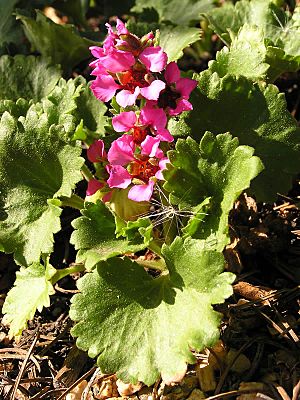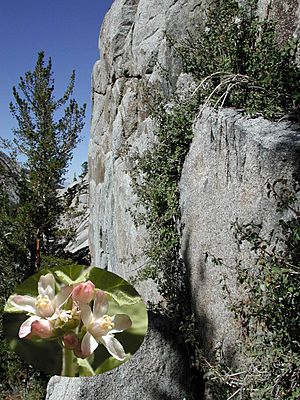Edwin James (scientist) facts for kids
Quick facts for kids
Edwin James
|
|
|---|---|
 |
|
| Born | August 27, 1797 |
| Died | October 28, 1861 (aged 64) |
| Nationality | American |
| Alma mater | Middlebury College |
| Spouse(s) | Clara Rogers |
| Scientific career | |
| Fields | Botany, Geology |
| Author abbrev. (botany) | E.James |
Edwin P. James (born August 27, 1797 – died October 28, 1861) was an important American scientist and explorer in the 1800s. He was a botanist (someone who studies plants), a geologist (someone who studies rocks and Earth's history), a linguist (someone who studies languages), and a doctor.
James played a big role in exploring the American West. He also worked to build friendships with Native Americans in the United States. Plus, he helped African Americans escape slavery.
Edwin James is best known for being part of a big trip called the Long Expedition from 1819 to 1820. This journey explored new lands that the U.S. had bought in the Louisiana Purchase. James joined during the second, most successful year of the expedition. This trip was the first scientific study of the western region. It greatly increased what people knew about the geography of the West. James was mainly in charge of writing the report about the trip. It was called Account of an Expedition from Pittsburgh to the Rocky Mountains, Performed in the Years 1819, 1820 and came out in 1823.
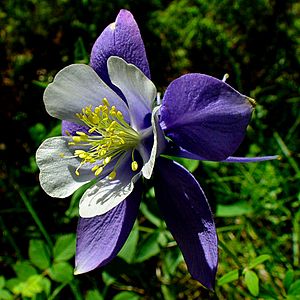
During the expedition, James made the first recorded climb of a mountain over 14,000 feet in North America. He was also the first to collect many kinds of alpine plants (plants that grow in high mountains). One of these was the "mountain Columbine," which is now known as the Colorado Blue Columbine. It later became the state flower of Colorado.
The expedition gathered a lot of information about plants, animals, geology, and geography. James's report, Account, was similar to the work of Alexander von Humboldt. Humboldt had explored Central and South America just 20 years earlier. The Long expedition even carried a copy of Humboldt's travel book.
James's Account also influenced many writers. Historian William H. Goetzmann said it was a very important book when it was published in 1823. People especially liked the parts describing the landscape, bison, and Native Americans.
Contents
Early Life and Learning
Edwin James was born in Weybridge, Vermont. His parents were Mary and Daniel James. He was the youngest child and grew up in a log house surrounded by woods. Edwin was a thoughtful and hardworking person. He loved to learn from nature and by reading many books.
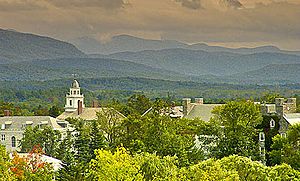
James went to Addison County Grammar School to get ready for college. He often walked five miles to attend Middlebury College. He started college in 1812 and earned his degree in 1816. After college, James moved to Albany, New York. There, he continued to study medicine with his brother, who was a doctor. He also studied botany with John Torrey and both botany and geology with Amos Eaton. In 1819, James joined the American Geological Society. Within a year, he had written articles about geology. Around the same time, he also made the first list of plants found in Vermont.
Exploring the Rocky Mountains
The second year of the Long Expedition started on June 6, 1820. The team, including 22-year-old Edwin James, left their winter camp. This camp was called Engineer Cantonment, near where Nebraska is today. They traveled west towards the Rocky Mountains, mostly following the Platte River. Then they went south along the Rocky Mountain Front Range. Finally, they headed east to finish the expedition on September 13, 1820, at Fort Smith in what is now western Arkansas.
Climbing Pikes Peak
On July 13, Edwin James and two other men decided to climb Pikes Peak. James wrote about their climb in his Account:
On the morning of the 14th... we continued the ascent, hoping to be able to reach the summit of the Peak... A little above the point where the timber disappears entirely, commences a region of astonishing beauty... covered with a carpet of low but brilliantly flowering alpine plants... We now found it would be impossible to reach the summit... but as we could not persuade ourselves to turn back... we resolved to take our chance of spending the night, on whatever part of the mountain, it might overtake us... We met, as we proceeded, such numbers of unknown and interesting plants, as to occasion much delay in collecting...
James described the top of the mountain and the amazing view in all directions. He even saw smoke in a valley to the north, which he thought meant a group of Native Americans was camped there.
This climb was the first time a white person had ever reached such a high mountain peak in North America. Pikes Peak is 4,302 meters (14,115 feet) tall. For a while, the mountain was even called "James Peak" in his honor. A hundred years later, a botanist named George Everett Osterhout said that this day was "undoubtedly the most notable day of the expedition for botanical collecting."
Discovering New Plants
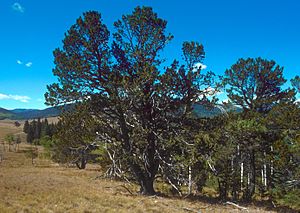
During the expedition, James collected about 700 different kinds of plants from the mountains and prairies. Out of these, 140 were completely new to science! Besides the Colorado Blue Columbine, James named many other species, like the Limber Pine (Pinus flexilis). Many plants were also named after him by other scientists. For example, the Cliffbush (Jamesia americana) is often found growing in cracks on high rock surfaces. In total, 24 plant species were named to honor Edwin James.
After the expedition, James and most of the team returned to the East Coast. Many of them got sick with malaria, which made their journey home slower. James finally reached Philadelphia in the autumn of 1821. He was given the main job of writing the Account of the expedition. He also had to organize all the collected information for publication. He finished this important work by the end of 1822. The James Peak Wilderness and its summit in Colorado were named after him.
Army Doctor
After the expedition, James became a surgeon for the U.S. Army. He worked at different frontier outposts, including places near the Great Lakes. He served in the Army from 1823 to 1833.
Helping Native Americans and Linguist Work
While in the Army, Edwin James spent time with Native Americans. He became very familiar with the language of the Ojibwe people. He worked closely with a Euro-American man named John Tanner. Tanner had been captured by the Ojibwe as a child and grew up with them. Together, James and Tanner helped create a version of the New Testament in the Ojibwe language. James also helped Tanner tell his life story.
Later, Edwin James worked as an Indian subagent for the Potawatomi people in Bellevue, Nebraska. There, he created spelling books for the children's education.
Life in Iowa and the Underground Railroad
In 1827, while still working for the Army, James married Clara Rogers. They had one son, Edwin Jr., born in 1828. In 1833, he was chosen to be a member of the American Philosophical Society, a famous group of thinkers and scientists.
In 1836, James started his own medical practice. He built a large stone house and a successful farm near Burlington, Iowa. At his house, James ran a station on the Underground Railroad. This was a secret network that helped enslaved people escape to freedom. He would hide people in baskets, barrels, and sacks. He even built a secret room behind a fireplace in his house. James helped these brave people travel north to freedom.
The Fugitive Slave Act of 1850 was a law that said people in free states had to return runaway enslaved people. But James was strongly against this law. He continued to help runaways throughout his life, even when it was dangerous. His neighbors supported him in his efforts to help people find freedom.
Clara, his wife, passed away in 1854. James himself died in 1861 after falling under the wheels of his wagon while loading firewood. Both of them were buried in the Rock Spring Cemetery. Years later, Rocky Mountain Blue Columbine flowers were planted around his grave to honor him.
Categories
See also
 In Spanish: Edwin James para niños
In Spanish: Edwin James para niños



